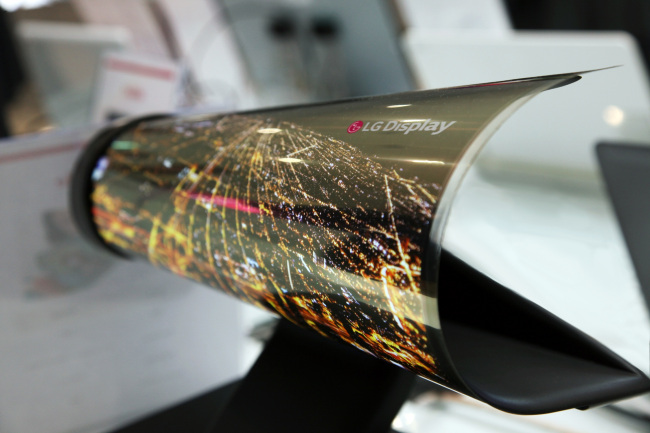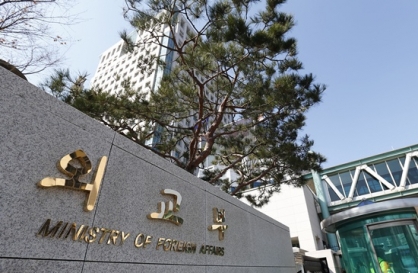OLED race heats up with increasing investment
Samsung will reportedly resume production of OLED TV panels next year
By 김영원Published : March 2, 2016 - 19:18
Despite a number of advantages to organic light-emitting diode displays, the market for the light and flexible display has yet to bloom.
Most major display and electronics makers have hesitated to jump on the OLED bandwagon, citing as main concerns the high production costs and low production yields of the promising OLED.
Things will likely change as Korea’s electronics and display powerhouses, including Samsung Display, have rolled up their sleeves to push for the growth of OLED display business.
Most major display and electronics makers have hesitated to jump on the OLED bandwagon, citing as main concerns the high production costs and low production yields of the promising OLED.
Things will likely change as Korea’s electronics and display powerhouses, including Samsung Display, have rolled up their sleeves to push for the growth of OLED display business.

Samsung Display has reportedly begun negotiations with local display equipment firms to add production facilities for OLED displays at the firm’s existing production line, called the A3, in Asan, South Chungcheong Province. The display business unit of Samsung Group will spend 9 trillion won ($7.3 billion) in total to build the production facilities where it is expected to churn out up to 30,000 OLED display sheets per month, according to news reports.
Samsung Electronics has put weight on producing small-sized OLED displays for mobile devices -- the company dominates nearly 90 percent of the OLED display sector for mobile devices. On the TV display side, the tech giant stopped manufacturing OLED TV and panels in 2012. It instead opted for liquid crystal display-based high-end TVs and those sporting LCD panels plastered with quantum dots -- fine electronic materials used to improve color contrast.
Market research firm IHS anticipated that Samsung Display would be equipped with production capacity of 495,000 square meters for OLED TV panels by 2017, and the figure would jump to 2 million square meters in 2018.
“Even though Samsung Display has not officially announced the investment plans for OLED TV panels, it is inevitable for Samsung Display to make investments for OLEDs, which can be used for various purposes like head-up displays,” a market official said.
LG Group affiliates LG Electronics and LG Display have pushed the envelope to move ahead of the pack in the OLED segment. For the past several years, LGE was the sole electronics firm producing OLED TVs and LGD was the only OLED TV panel manufacturer.
“Since LGE has nearly been dominating the global OLED TV market, it will be able to enjoy a first-mover advantage in the high-end TV market,” said Kim Rok-ho, an analyst from Hana Daetoo Securities, in his investment report.

Believing OLED displays will become mainstream in the coming years, LG Display has also made rounds of investment for the flexible display in the past several years.
The display affiliate of LG Group announced last year that it would pour in a whopping 10 trillion won to add new production lines for OLED displays at Gumi in North Gyeongsang Province and Paju in Gyeonggi Province.
It is expected that the series of investments for the OLEDs by LGD will create around 104 trillion won worth of production and 350,000 jobs.
The company will reportedly supply OLED panels to carmakers Mercedes Benz and Audi. These panels will be used for car dashboards.
The LG Group affiliates are said to be working on futuristic products including rollable TVs and foldable smartphones sporting OLED displays.
Some market watchers forecast that rollable TVs will be showcased next year.
By Kim Young-won (wone0102@heraldcorp.com)




![[Weekender] Korean psyche untangled: Musok](http://res.heraldm.com/phpwas/restmb_idxmake.php?idx=644&simg=/content/image/2024/05/02/20240502050841_0.jpg&u=)

![[Eye Interview] 'If you live to 100, you might as well be happy,' says 88-year-old bestselling essayist](http://res.heraldm.com/phpwas/restmb_idxmake.php?idx=644&simg=/content/image/2024/05/03/20240503050674_0.jpg&u=)










![[Herald Interview] Director of 'Goodbye Earth' aimed to ask how we would face apocalypse](http://res.heraldm.com/phpwas/restmb_idxmake.php?idx=652&simg=/content/image/2024/05/03/20240503050732_0.jpg&u=)
